Forward to the Past
The future of acoustic treatment goes back to the ‘40’s.
The 1960’s are often regarded as rock’s finest decade, producing music that became the template for much of what followed. The recording studios in which this iconic music was created were mostly live-sounding rooms – the trend toward very dead-sounding rooms didn’t start until the 1970’s, when studios discovered fiberglass insulation.

John Calder (seated, with guitarist Mike Coates) at AudioTek Studios, in the ‘70’s
My first job in a recording studio, at AudioTek Studios in North Minneapolis in the ‘70’s, was putting up a boxcar-load (literally!) of fiberglass four inches deep on the walls and ceilings of the huge main room. Back then, fiberglass batting was the new go-to solution – put up a ton of this stuff and magically ‘fix’ your room. The dead acoustics reduced ambient microphone leakage, making overdubbing vocals, guitars, or just about anything, easier.
And that’s when the trouble started. I’d go home after a long day of attaching fiberglass batts to twenty-foot-high ceilings and watch glass particles float to the top of my bath water. Not good. But far worse than my aversion to being covered in (and breathing in) glass spicules was the affect this massive amount of absorption had on the sound – the life went out of the room and often out of the performances. “Getting a sound” became a marathon struggle against the acoustics. Not good.
In the ‘80’s, working at a state-of-the-art studio in Burbank (Kendun Recorders), I learned that a well-designed recording studio can be an exciting, performance-enhancing space. Acoustic designer Tom Hidley had created a multi-zone set of acoustic environments – diffused areas, absorbent areas, combination areas – which were a joy to use, a multi-tool for optimizing sound and performance.
Yet here in the mid-2010’s, some of you are still leaning heavily on fiberglass-only treatments to ‘fix’ your rooms. Not good. We have better options, and one of the best comes from the 1940’s, pioneered by ground-breaking facilities like Bell Labs and RCA Studios – polycylindrical diffusion. Today we can mix-and-match the two “opposites” of absorption and diffusion to create better-sounding, more-flexible spaces. Our Curve Diffusor is an improved version of the RCA polycylindicals, and our acoustic-cotton absorption material – Echo Eliminator – is a non-spicule, non-VOC absorbent material that compares very well acoustically with fiberglass.
Let’s use the entire history of acoustic developments in our modern rooms, not just the over-damped, lifeless rooms of the ‘70’s – I got through that decade’s over-use of absorbers, and so can you. Mixing cylindrical diffusion with cotton absorption – very good!











5 comments on “Forward to the Past”
Vicky King
John Calder – I’ve been looking for any memorabilia or photos (outside and inside) from the old Audio Tek studio in Minneapolis. Would any log/schedule book or reel to reels exist? My husband and brother recorded there in 1971 and 1972. Cool memories. Any clue on contacts about this? Thanks! Vicky King
John Calder
Hi Vicky,
There are a few photos scattered around the internet for AudioTek Studios, but not many. The owner died many years ago, and I haven’t found any way to connect with his family, if any are still out there. I worked there from 1970 until 1973, but I have no photos at all.
Thanks for the note, though, and good luck with your search!
John Calder
Vicky King
Hi John! When you worked at Audio Tek in the early 70’s, was there an outside sign on the building and if so, what did it look like? Just tracking memories! Thanks… Vicky King
Jim King
Hey, John. I’m Jim King. Vicky is my dear wife. I recorded at Audio Tek in 1971 and 1972 with Larry David James. I’m sure you don’t remember us but, we had a blast making two 45s and that experience has stayed with me. Currently, I have a project studio where I record, mix, master, and produce area talent. I’m always learning even at this age. I was wondering what console was at Audio-Tek, what ever happened to it and what happened to Audio-Tek? How are you involved in audio at this time? Wishing you the best. Jim King
John Calder
Hi Jim,
Nice to hear from you! AudioTek Studios went out of business sometime in the late ‘70’s, I think – just as well, because not long afterward, the roof of the building fell in. There’s a Target store on that corner now.
The first console was built in-house, and used UA and Langevin components. The second console was an MCI JH-428, with a Scully 24-tape deck.
I’m still learning, too – it’s a constant, and it’s a good thing!
Thanks again,
John